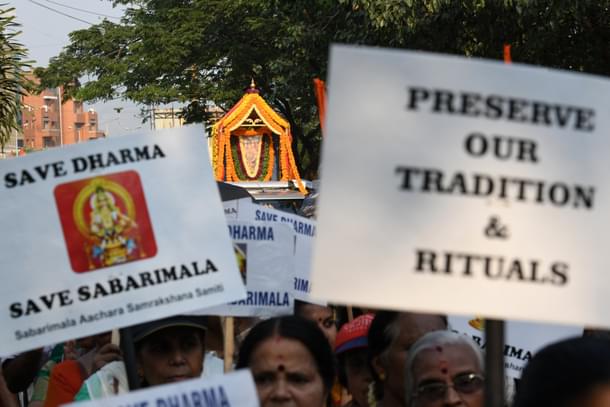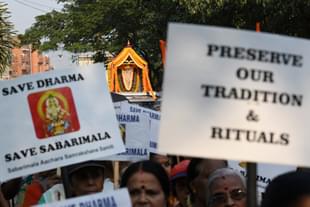Politics
As The Gates To Sabarimala Temple Open Today, Here’s The Issue As It Stands
Swarajya Staff
Nov 06, 2018, 09:01 AM | Updated 09:00 AM IST
Save & read from anywhere!
Bookmark stories for easy access on any device or the Swarajya app.


Even before the pictures of state police pelting stones on the devotees of Lord Ayaappa protesting at Sabarimala and vandalising their vehicles could be forgotten, the Communist Party of India (Marxist)-led government of Kerala has converted the temple town into a fortress prepared to go to war. However, unlike in the olden days, the ‘enemy’ is inside the fortress itself — the women and men protesting against interference of the state and its institutions in their religious practices.
Preparing to use unprecedented force against the devotees, the state government has deployed over 2,300 police personnel, including a 20-member team of commandos and 100 women security personnel, to force the entry of women of reproductive age into Lord Ayyappa’s adobe. The temple will open its doors today at 5 pm for the "Sree Chitira Atta Thirunal" special puja slated for the next day, marking the birthday of last king of Travancore Chithira Thirunal Balarama Varma, and close at 10 pm on that day. This will come weeks after it was closed amid the government’s crackdown on devotees protesting against the Supreme Court’s controversial ruling overturning a centuries-old tradition restricting the entry of women of certain age into the hilltop shrine. This is just the second time that the temple will open after the apex court’s ruling, with which the only woman in the five-judge bench dissented.
Those against the Supreme Court’s move have argued that the primary objective of the practice was to preserve and honour the celibacy of the deity, Lord Ayyappa. During the hearing, lawyer J Sai Deepak, representing a non-profit organisation called ‘People for Dharma’, put forward evidence from various religious texts before the bench, establishing the celibate nature of the deity. He stated that the charge of discrimination against women would’ve been justified if the practice restrained “all women”, but that’s not the case.
Sai Deepak said that the issue was not about “temple vs women” or “men vs women”, but “men v men” and “women vs women”. If the petitioner’s contention were allowed, then men who don't observe the 41-day vow can also claim right of entry into the temple citing Article 25(1) of the Constitution. A Hindu might say that he wants to offer meat to Lord Ganesha citing Article 25(1) and so on. (Read: ‘People For Dharma’ Lawyer Leaves Court Spellbound; Here Are His Arguments).
At one point during the hearing in the case, when Sai Deepak got a nod of appreciation from the Supreme Court for his arguments against the entry of women of reproductive age, it seemed that the apex court would rule in favour of the tradition. However, it did not. The court’s decision triggered massive protests, many of which were led by women themselves. When the temple opened after the ruling for the first time last month, the protest intensified. On the day the temple was to open its doors, the nation woke up to the pictures of the state using brute force to overpower women camping along the roads leading to Sabarimala to protest against the ruling. Despite protests, the state government chose not to file a review petition.
Police deployed by the state government to escort activists to the temple was seen pelting stones on the devotees protesting against the apex court’s verdict and indulged in vandalisation of their vehicles. Multiple devotees, including Rahul Easwar, were arrested for protesting. By 26 October, the police had arrested at least 3,400 people as part of the crackdown while 517 cases had been registered across the state. Showing the kind of alertness not seen often, the police released pictures of devotees involved in protests and launched a massive hunt by forming special team in each district of the state to identify them. The state’s law and order machinery, which has failed miserably at curbing the spread of Wahabism and the influence of the Islamic State, worked overnight to bring to book unarmed protesters expressing disagreement with a ruling of the court. The state’s communist government seemed hell bent on punishing the protesters for simply objecting to a ruling, implementing which was seen as helping its political agenda ahead of the assembly elections in 2019. It was as if the government was competing with Mulayam Singh, who as the Chief Minister of Uttar Pradesh in 1990 ordered the police to open fire on kar sevaks marching towards Ayodhya.
The protesters, however, refused to give up. By the time the temple shut its doors last month, the state government and its machinery had failed to force the entry of women of reproductive age into the temple. Between then and today, the Supreme Court has refused to entertain a request for urgent hearing of a plea seeking review of its judgement even as it imposed a partial ban on firecrackers ahead of Diwali. In both these cases, evidence based arguments fell on deaf ears.
Different temples in India have their respective histories and traditions. The question is, if the Indian state interferes in the religious practices of one of them, who can stop it from interfering in the traditions of other temples tomorrow?
Through the Sabarimala judgement, the judiciary has already placed events on a slippery slope. The protesters in Sabarimala and throughout India may now decide that they would let it slip only so far.
Events during the course of the day will have a bearing on the future of the movement to free temple from the control and interference of the government and institutions of the state. If the state and the court have their way today, the unwinding of the diverse traditions of Hindus will continue unabated.
The Sabarimala issue has brought questions over temple control into national discourse. Click here to read our latest issue, Leave Our Temples Alone.
Also read: Mandir Bachao: Why Sabarimala Is More Important Than Ram Mandir Right Now





